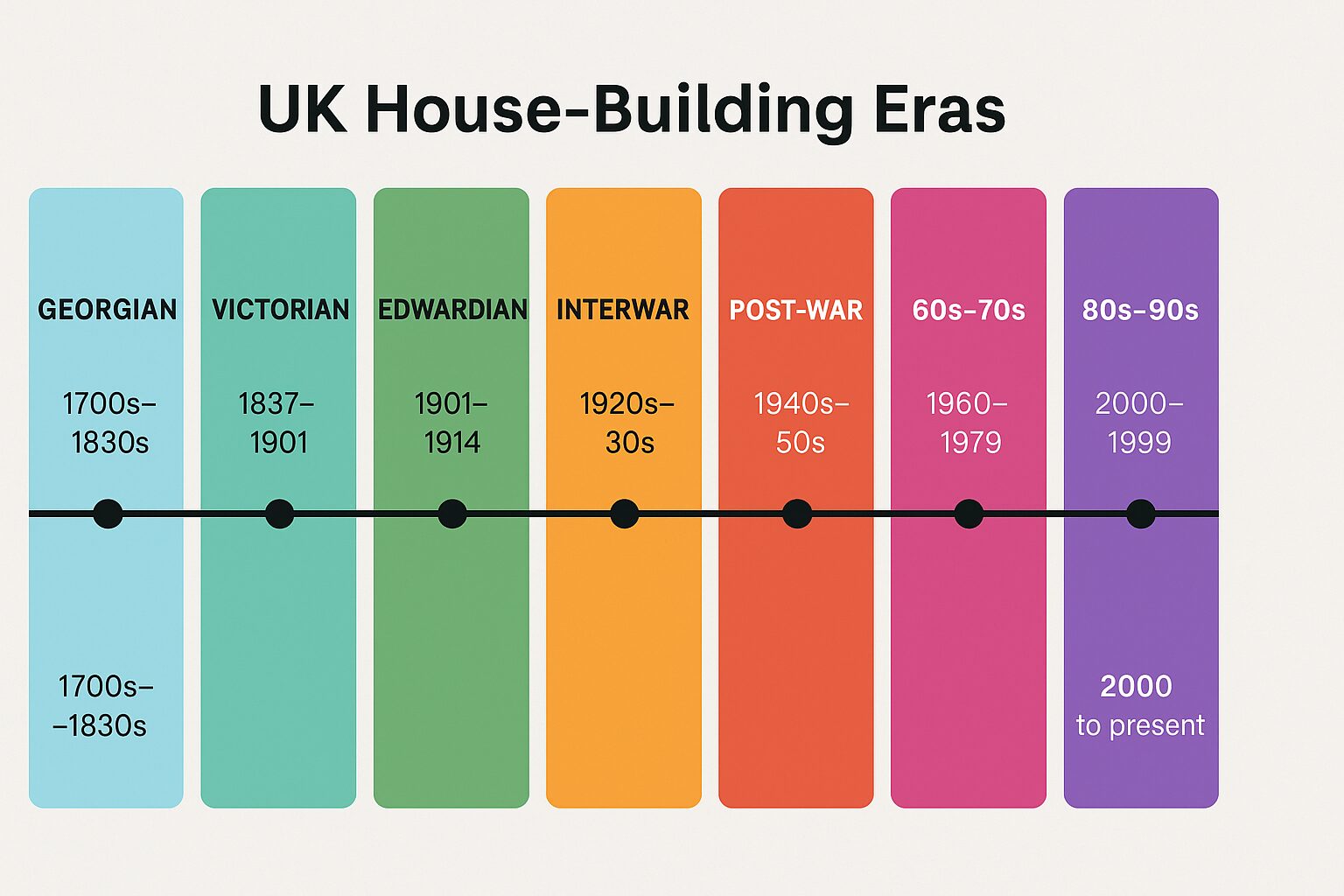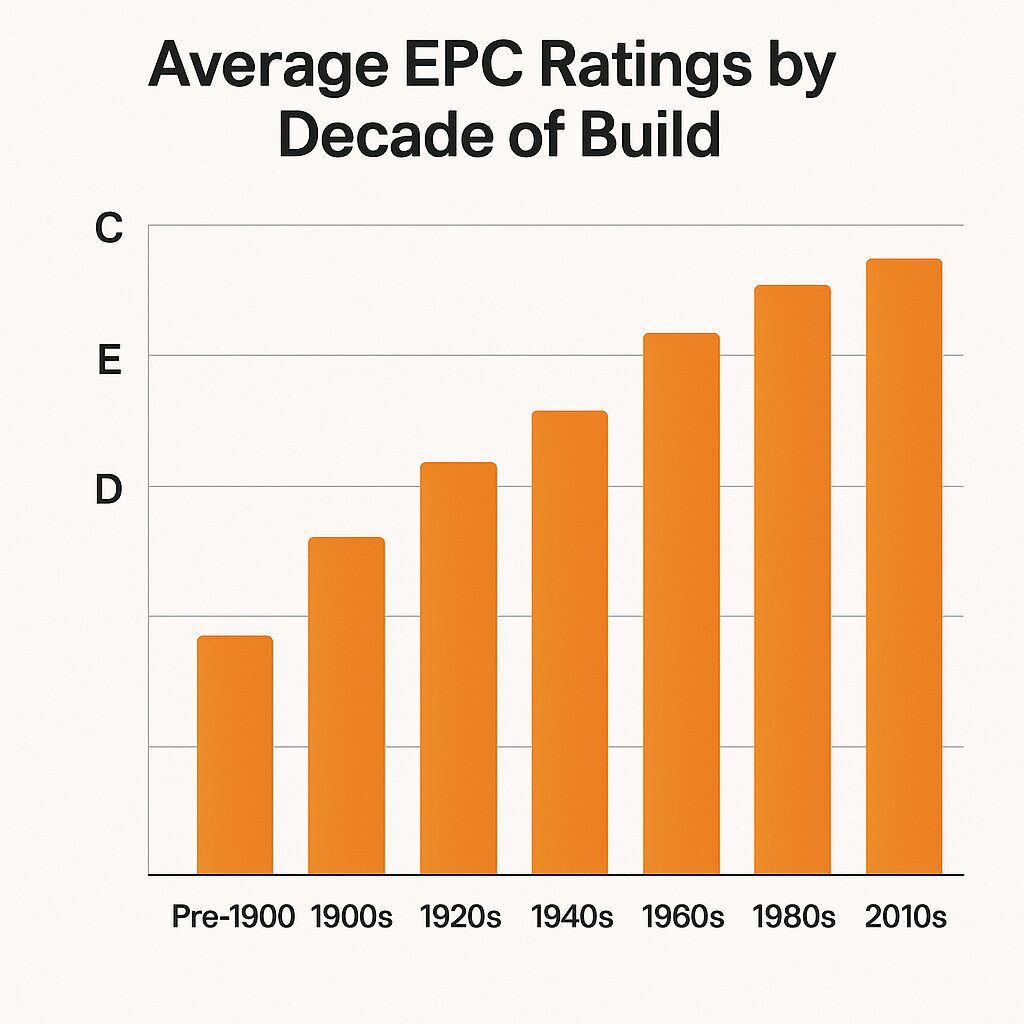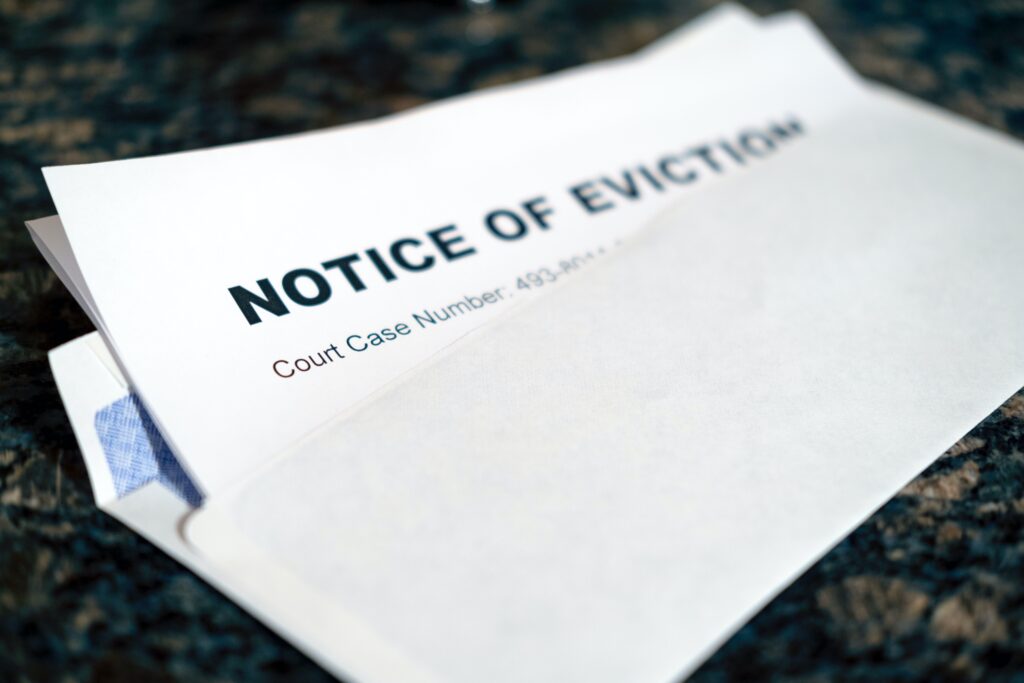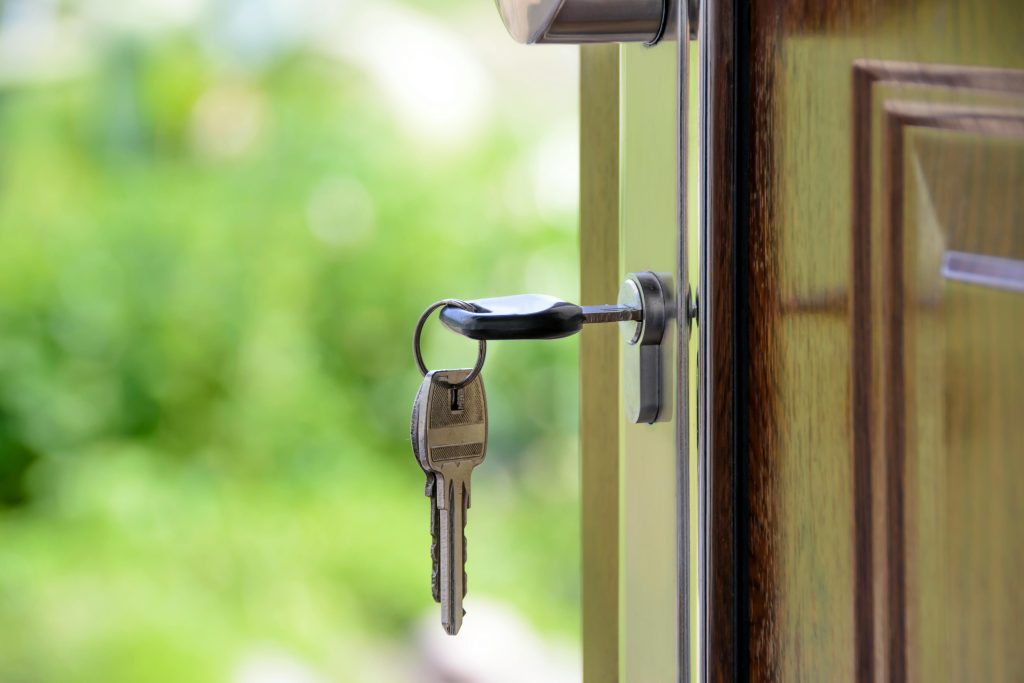Ever looked around your home and wondered just how old it really is?
Maybe you suspect it’s got Victorian bones. Or maybe you think it’s a ’90s build that’s seen better days.
Either way, knowing when your house was built isn’t just a fun bit of trivia. It can affect your insurance, what kind of repairs to expect, what you’re allowed to change, and how much your home is worth.
In this guide, I’ll walk you through how to discover when your property was built — from spotting architectural clues, digging through paperwork, to using government records and local archives.
Let’s get started.
How to Tell When Your Home Was Built (Step-by-Step)
There are a lot of ways to work out when your home was built — some fast, others more old-school. We’ll start with the easy wins and move into the deeper research.
Step 1: Spot the Clues in the Architecture
Your home’s design often gives away its age.
Here’s what to look for:
Date Stones or Plaques
Start with the obvious. Any plaque above the door? Foundation stone in the wall? Gate post engraving?
You might see:
- “Built 1892”
- “Erected by XYZ Ltd, 1935”
- Or just a house name with a date
Top tip: Make sure it’s not the date of an extension — you’re after the original structure.
Architectural Style

Can you spot any of these features?
| Style | Typical Years | Clues |
| Georgian | 1700s–1830s | Symmetry, sash windows, brick arches |
| Victorian | 1837–1901 | Bay windows, iron railings, roof gables |
| Edwardian | 1901–1914 | Larger panes, red brick, stained glass |
| Interwar | 1920s–30s | Curved bays, mock-Tudor timber, leaded glass |
| Post-war | 1940s–50s | Simple layouts, render, flat frontages |
| 60s–70s | 1960-1979 | Modernist blocks, hung tiles, large windows |
| 80s–90s | 1980-1999 | Neo-Georgian doors, integrated garages, uPVC windows |
| 2000s+ | 2000–present | Open-plan layouts, steel/glass, eco features |
Still not sure? Check neighbouring houses — especially in a terrace or estate. They’re usually the same age.
Step 2: Examine Construction Materials and Features
Noticing what your home’s made of can offer big clues:
Walls
- Solid brick walls (no cavity): pre-1920s
- Cavity walls (two brick layers with a gap): 1930s onwards
- Very thick stone walls: likely 18th or early 19th century
Look closely at the brick pattern:
- Flemish bond or English bond (alternating patterns): 18th–19th century
- Stretcher bond (all laid lengthwise): 20th century onwards
If you see bricked-up windows, you might be looking at a home built during the Window Tax era (1696–1851) — common in Georgian homes.
Roof
- Thatched roofs: pre-20th century, often rural cottages
- Slate tiles: common in Victorian/Edwardian homes
- Concrete tiles: post-WWII and later
Interior Features
- High ceilings and ornate fireplaces: Georgian or Victorian
- Low ceilings and simple finishes: post-war builds
- Original plaster mouldings or ceiling roses: 1800s or early 1900s
- Open-plan layouts: likely 2000s or a modern renovation
And don’t forget the loft or basement — builders often scribbled dates on beams or walls.
Check Your Property’s Paper Trail
Before diving into archives, rummage through your own documents first:
Title Deeds or Title Register
Got the original title deeds? They might say:
“Lot 12 of the 1887 estate… house erected in 1886.”
No deeds? No problem — the Title Register (from HM Land Registry) can still help.
Even if it doesn’t list a build year, it might show the first transfer from the developer — giving you a solid estimate.
You can get it for £3 online via the GOV.UK Land Registry site.
Seller’s Property Information Form (TA6)
Bought the place recently? Your solicitor should’ve given you this.
It often includes the build date — even if it’s approximate (e.g. “circa 1950”).
Mortgage Survey or Valuation
If you had a mortgage, the lender will have arranged a survey. These usually state:
“The property is estimated to have been built in the early 19XXs.”
Check your HomeBuyer Report or full Building Survey.
Energy Performance Certificate (EPC)
Homes sold or rented since 2008 should have one.
The EPC lists the estimated build date, like:
- “Built in 1978”
- “Built between 1900–1929”
No copy? Look it up for free using the EPC register online.

Old Sales Brochures or Warranties
If your home’s a newer build (1980s onwards), you might find:
- NHBC warranty docs (valid for 10 years, with a build date)
- Original brochures from when the estate was sold
- Instruction manuals for appliances that mention “New Homes, Built 1995”
These little bits of info add up.
Planning History & Local Authority Archives
Your local council’s records could hold the blueprint to your home’s origin story.
If your house was built post-WWII — or even just heavily altered — there’s a solid chance your council has records on file. And even if you live in a 200-year-old cottage, there could still be documentation buried in conservation or heritage listings.
Here’s how to dig into your area’s planning history and uncover what’s on the books.
Planning-Portal Applications
Find the original construction approvals and past renovations through your council’s planning portal.
Most UK local authorities now host online planning application databases. These are packed with:
- Historical planning approvals (new builds, extensions, loft conversions)
- Site layout plans and elevation drawings
- Details of builders, developers, and timelines
What to search:
- Your street name (broader than just your house number)
- Planning reference numbers (if you have old paperwork)
- Keywords like “erection of dwellings”, “estate development”, “conversion”, etc.
Top tip: Start by filtering oldest to newest. Many applications from the 1950s onwards have been digitised. If your house was built in the last 70 years, the original approval is likely still archived.
Pro move:
If you find a development application for your whole street or estate, it likely contains:
- The first mention of your home
- A timeline for when the area was built
- Names of builders or architects
1. Historic Environment Records (HER)
Use your county’s HER to access archaeological and architectural data about your property or area.
Most counties and unitary authorities maintain a Historic Environment Record (HER) — a local database of:
- Archaeological finds
- Historic buildings and sites
- Historic landscapes and architectural notes
HERs are used by developers, researchers, and conservation officers — but you can search them too.
Where to find HERs:
- Via your county council’s website (search “[Your County] HER”)
- Through Heritage Gateway (www.heritagegateway.org.uk) – covers England
- For Wales, use Coflein (https://coflein.gov.uk)
- In Scotland, visit Canmore (www.canmore.org.uk)
What you’ll get:
- Detailed heritage listings by grid reference
- Notes on architectural style, use, modifications
- Sometimes, early planning references or archaeological assessments
Why it matters:
Even if your house isn’t listed, HERs might confirm it sits on a historic site, is part of a former estate, or was built using protected materials — all of which affect how you maintain or modify the property.
2. Conservation Area & Listed Building Constraints
Discover if your home is protected — and what that says about its age.
If your property is in a Conservation Area or is Listed, the local authority will have documentation that helps date it — and outlines exactly what you can and can’t do with it.
What to check:
- a) National Heritage List
Search your postcode on the National Heritage List for England (or Cadw / Historic Environment Scotland if you’re in Wales or Scotland).
You’ll see:
- Construction date (approximate or exact)
- Description of features and historic importance
- Grade (II, II*, or I)
- b) Conservation Area Appraisals
These are PDF documents published by councils when a conservation area is designated.
They often contain:
- Maps of the designated area
- Building-by-building breakdowns
- Date ranges for architectural phases
- Notes on alterations, materials, and heritage constraints
Find these by googling:
“[Your council] conservation area appraisal [your area name]”
Why it’s useful:
These records don’t just help you date the house — they tell you what it was considered significant for. That’s powerful when selling, renovating, or applying for planning permission.
Maps, Directories & Census Returns
When official records fall short, old maps and dusty directories can fill the gaps.
Modern digital records only go so far. If your property predates the Land Registry system or EPCs, you’ll need to step back in time — literally. And this is where historical documents come into play.
We’re talking Ordnance Survey maps. Kelly’s Directories. Old electoral rolls and census sheets.
They may not give you a precise build date, but they can tell you exactly when your house first showed up in the public record — and that’s often just as good.
Old Ordnance Survey & Tithe Maps
See when your home first appeared on the map — literally.
The Ordnance Survey (OS) has been mapping the UK since the late 1700s. By comparing editions of these maps, you can often pin down a construction window of just a few years.
Here’s how to do it:
Visit the OrdnanceSurvey.co.uk website and pay to access the map of your area. If in Scotland go to National Library of Scotland’s map site
Example:
If your plot is empty in 1893 but developed in the 1905 edition, your house was almost certainly built between those years.
Want more details?
- Many local archives and county record offices also hold tithe maps, estate maps, and building plans — worth contacting them if your property is rural or pre-1850.
Street-by-Street Directories & Kelly’s
Find the first recorded appearance of your address — and who lived there.
Back before the internet, town directories (like Kelly’s or Post Office listings) were the go-to reference for addresses and local businesses.
They’re still incredibly useful today for dating old properties.
What to do:
- Head to your local studies library or archive
- Ask for:
- Kelly’s Directories
- Trade directories
- Post Office Directories
- Electoral Registers
What to look for:
- The first time your street is listed
- The first appearance of your house number or name
- Names of early residents (which you can cross-check with the census)
Tip:
If your address doesn’t appear in the 1900 directory, but pops up in 1904 — you’ve nailed your build window to within four years.
Census Records (1851–1911)
Use UK census returns to find out when your home was first lived in — and by who.
The UK census has been conducted every 10 years since 1801. From 1841 onward, it includes names, occupations, and — crucially — addresses.
Where to search:
- Ancestry.co.uk
- Findmypast
- Your local library (most have free access to one or both)
What to do:
- Search by street name (and house number if known)
- Look for the first year your address appears
- Note the family name, head of household, and profession
Pro tip:
If your street is listed in the 1871 census but not in 1861, chances are your home was built in the 1860s.
Bonus:
Census entries can also reveal what your house was used for:
- A family home
- A boarding house
- A staff cottage or gatehouse
That adds colour to the history — and helps with conservation or resale narratives later.
Online Tools & Commercial Services
If you’re short on time (or patience), online resources can do a lot of the legwork for you. Some are totally free, others cost a few quid — but all of them can give you fast clues about your property’s age.
And if the DIY route doesn’t cut it? There are experts and commercial databases that can dig deeper, right down to the mortar.
Here’s the full rundown.
1. EPC Register
If your home has been sold or rented since 2008, it should have an Energy Performance Certificate (EPC). These list:
- The year (or date range) your house was built
- Basic construction type (wall type, glazing, insulation)
Where to search:
2. HM Land Registry Title Register
For £3, you can download your Title Register — the government record of ownership.
If the property was sold by a developer when it was first built, that first transfer date is usually a dead giveaway for the build year.
Site:
3. National Library of Scotland Maps
We mentioned this under maps, but it deserves a second shout here — you can compare your street in 1890 vs 1905 in seconds.
Free property data tools
Sites like:
- PropertyChecker.co.uk
- Mouseprice
- Zoopla & Rightmove (check historic listings)
They can tell you:
- The “Year Built” (estimated)
- Historic sale prices
- EPC results
Heads up:
These sites pull from public records — so they’re only as accurate as the underlying data. For homes that haven’t sold in decades, results might be patchy.
If free tools don’t cut it, these services offer more granular insights.
1. Property Information Packs
Some companies offer downloadable packs with:
- Historic land transfer dates
- Planning application history
- Flood and subsidence risks
- Estimated build year based on multiple sources
You’ll often find these offered by conveyancing firms or property search companies. Prices range from £10 to £50, depending on depth.
When you want the full picture — or an expert to confirm your findings.
1. Hire a chartered surveyor
A Level 3 Building Survey will usually include:
- Estimated build year
- Structural features that indicate age
- Professional assessment of build materials
Perfect if:
- You’re doing major work
- Need to confirm age for insurance
- Want evidence for a heritage claim or grant
2. Hire a house historian or heritage consultant
For listed or unusually old homes, a specialist can:
- Search archives on your behalf
- Use land records, wills, rate books and estate maps
- Even date old timbers using dendrochronology (tree ring dating)
It’s a niche service — but a proper report from a house historian can be a brilliant asset, especially for resale or restoration.
Pro tip:
Many homeowners only dig this deep when applying for planning permission, dealing with insurers, or selling a historic home. But even if you’re just curious, the info you uncover can help you maintain or modernise your home properly — and protect its value.
Estimating When Records Are Sparse
No EPC, no planning files, no maps? Here’s how to work it out anyway.
Sometimes, no matter how deep you dig, there’s just… nothing. No title deeds. No EPC. No clear planning reference. It happens — especially with older homes or inherited properties that haven’t changed hands in decades.
But that doesn’t mean you’re stuck. Here are three solid ways to narrow down your home’s build date when records are light on detail.
Neighbourhood Comparison
Your neighbours might hold the answer — or at least a pretty good clue.
If your property is part of a terrace, semi-detached pair or post-war estate, there’s a strong chance it was built at the same time as surrounding homes.
Here’s how to use that to your advantage:
- Check neighbouring properties for date plaques (front walls, gateposts, foundation stones)
- Ask long-time residents when the estate was built — some will remember it going up
- Look for archived property listings (Rightmove or Zoopla often still have old sale records with year built)
Pro tip:
If No.12 has an NHBC certificate from 1994, yours (at No.10) probably does too. Same goes for planning approvals or builder names etched into extension walls.
Building Surveyor’s Visual Analysis
Let a professional tell you what the structure’s saying.
If you’re struggling to pin down the age yourself, a Level 3 Building Survey (or a historic building specialist) can give you a detailed estimate based on:
- Roof truss shape and material
- Mortar type (lime vs cement)
- Wall thickness and bonding pattern
- Window styles and brick detailing
- Foundation depth (older homes = shallower)
Even seasoned contractors and heritage builders can often look at the brickwork or layout and say, “Ah — classic 1920s cavity wall job” or “That’s late Victorian, easy.”
Cost:
Expect to pay more for a specialist heritage survey — but it’s well worth it if the property is listed, unusual, or structurally modified over time.
Dendrochronology & Material Testing
If you’ve got a timber-framed home — science can literally date the trees.
This is one for the hardcore heritage sleuths.
Dendrochronology (tree-ring dating) can establish the year a timber beam was felled. It’s often used on:
- Tudor or medieval buildings
- Listed cottages with exposed beams
- Timber-framed barns and conversions
Other lab-based dating options include:
- Mortar analysis (helps confirm period of stone or brick walls)
- Lead paint testing (specific to certain construction eras)
Is it worth it?
For standard homes? Probably not.
But if you own a suspected 17th-century house or want to prove a claim for conservation or grant funding — these methods offer scientific backing.
In short, when formal records dry up, it’s about combining clues:
- What the house looks like
- What your neighbours know
- What professionals can confirm on-site
And if all else fails? You can usually get close enough for insurance, resale, or renovation planning purposes.
Ready to Take the Next Step?
Sometimes, learning the age of your house highlights… bigger problems.
Maybe the roof’s 70 years old and sagging. Maybe it’s a listed cottage that needs costly repair. Or maybe you just don’t fancy managing a sensitive renovation.
If that’s the case, and you’re thinking of selling, Property Rescue can help.
We:
- Offer fast, no-fuss property purchases of all properties in all conditions.
- Buy properties of all ages — even historic or listed
- Work with sellers who need speed, certainty, or simply a clean exit
No estate agents. No repairs needed. And we appreciate heritage homes and we’d love to buy yours ASAP.
Thinking of selling? Get a no-obligation cash offer from Property Rescue and see what your home could fetch — even without lifting a paintbrush.








